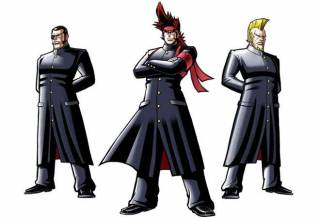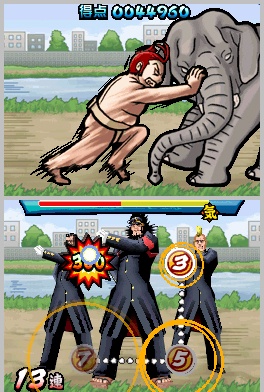Overview
The Ouendan franchise is made up of a series of rhythm games for the Nintendo DS developed by iNiS and published by Nintendo. The first and third games in the franchise, Osu! Tatakae! Ouendan and Moero! Nekketsu Rhythm Damashii: Osu! Tatakae! Ouendan 2 were released only in Japan. However, the original game became a popular import title, leading to a spin-off being created for the western market entitled Elite Beat Agents.
Concept
 Three Ouendan members: Ryuuta Ippongi (center), Saito, and Suzuki.
Three Ouendan members: Ryuuta Ippongi (center), Saito, and Suzuki.In the Japanese Ouendan titles, the player takes the role of an ouendan; a type of male cheer squad unique to Japanese culture. In Elite Beat Agents, the protagonists are a group of secret agents whose weapons are song and dance. The games feature everyday people facing crises ranging from the mundane to the fantastic, and it's the job of the Ouendan/EBA to keep their spirits up so that they can best their obstacle, whether they be a high school student taking an entrance exam, a blocked novelist needing to write an entire romance novel in a single evening, or a pro baseball player fighting a magma golem.
Gameplay
Each stage begins with a brief introduction of the hapless protagonist that the Ouendan/EBA must help and the crisis that must be overcome. This is then followed by a series of gameplay sequences set to a particular song with brief cutscenes at break points used to rate the player's progress. The player must keep in rhythm with the song by interacting with three kinds of markers.
Hit Markers
These are numbered circles that appear on screen that must be tapped with the stylus in the proper order. Colored halos shrink around each one. To stay close to the beat, the player must tap the marker when the halo overlaps its edge.
Phrase Markers
These are Hit Markers with tracks that extend outward from them. When tapped, the player must trace the stylus along the track in time with a rolling ball. If an arrow is at the other end of the track, the player must run the stylus back over the track in the other direction. It's not uncommon for Phrase Markers to require sliding the stylus back and forth several times.
Spin Markers
The rarest kind of marker, it is most commonly seen at the end of each song or just before a song's break point. When it appears, the player must simply use the stylus to spin a colored wheel as quickly as possible in order to fill up a gauge along the side of the screen. Spinning the marker fast enough can earn hefty amounts of bonus points.
Difficulty Modes
 Sumo wrestler in need of training? Not a problem for these guys.
Sumo wrestler in need of training? Not a problem for these guys.Each game in the franchise has four levels of difficulty. The names of the difficulty levels depend on the game, but correspond to Easy, Normal, Hard, and Insane. The difficulty level adjusts the number of markers that appear on screen and the speed with which they must be hit. The track patterns seen in Insane Mode are the mirrored forms of those seen in Hard Mode with some tweaks, but also shrink the size of the markers and leave them on screen for much shorter periods of time, making them much more difficult to hit. The difficulty level also affects which Ouendan/EBA squad the player controls. On the hardest difficulty setting, the male characters are replaced with a female cheer squad.
Music Variety
The Ouendan franchise typically features pop music from a diverse span of eras, ranging from recent hits to songs dating back to the 1970s. Most of the songs in the series are covers, though the original Ouendan and Ouendan 2 both feature at least one song that uses the original recording.
Series Influence
The gameplay in the Ouendan franchise has gone on to influence the direction of development for other DS games as well. The DS version of Happy Feet, for instance, uses a very simple form of Ouendan-style gameplay that focuses only on Hit Markers, while Assassin's Creed: Altair's Chronicles adapts the gameplay mechanics to work outside the context of a music/rhythm game.
Log in to comment